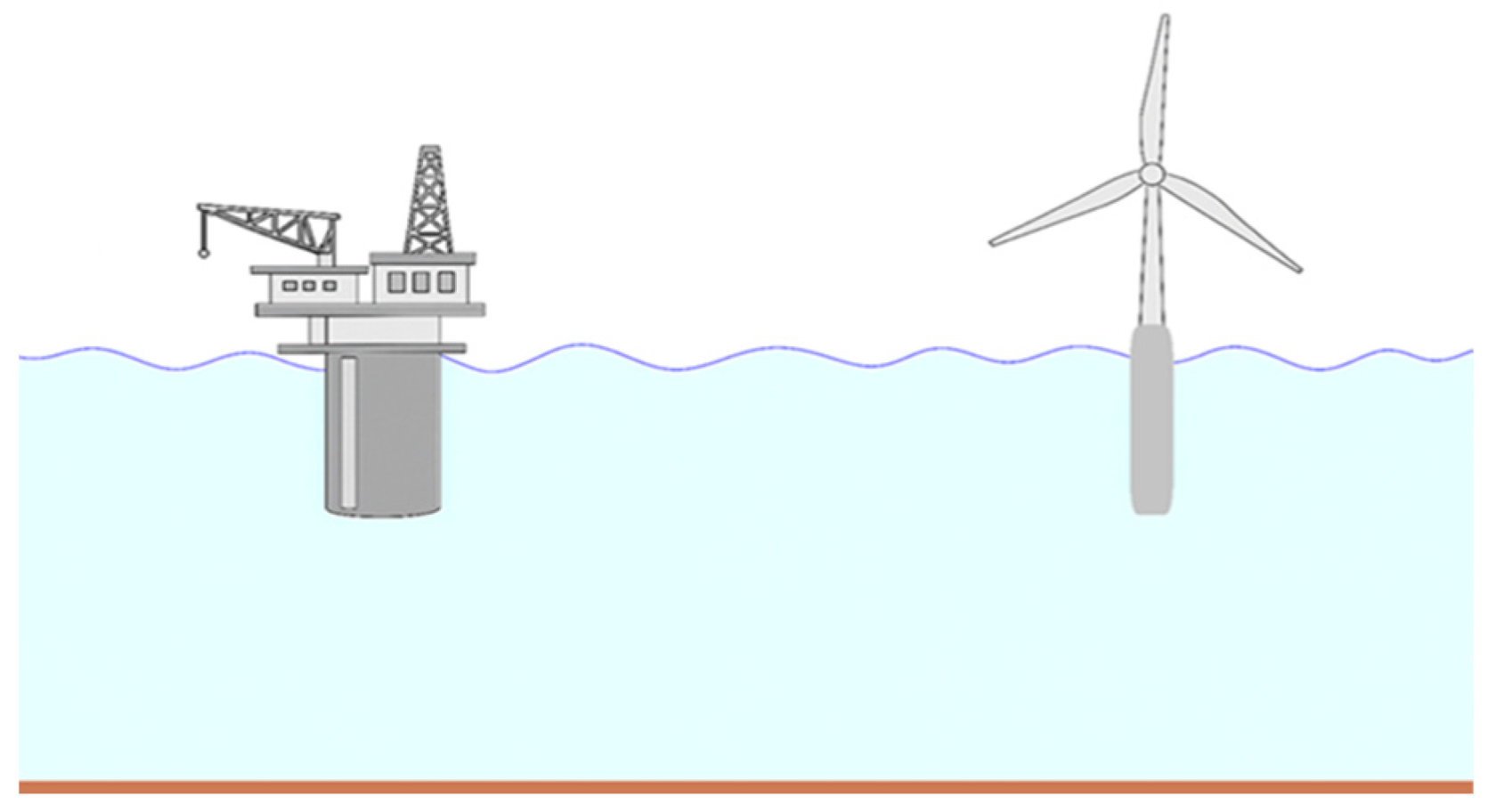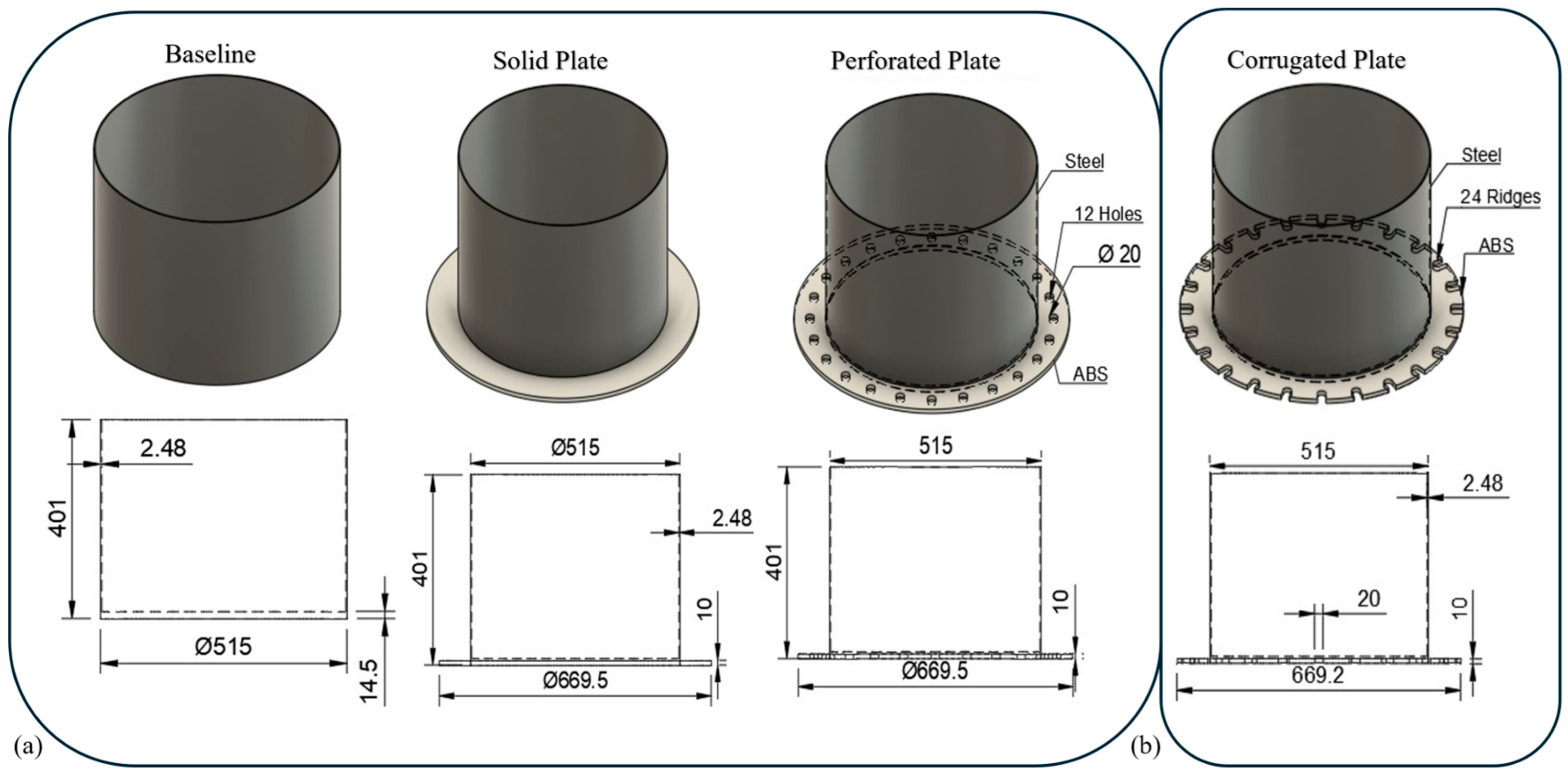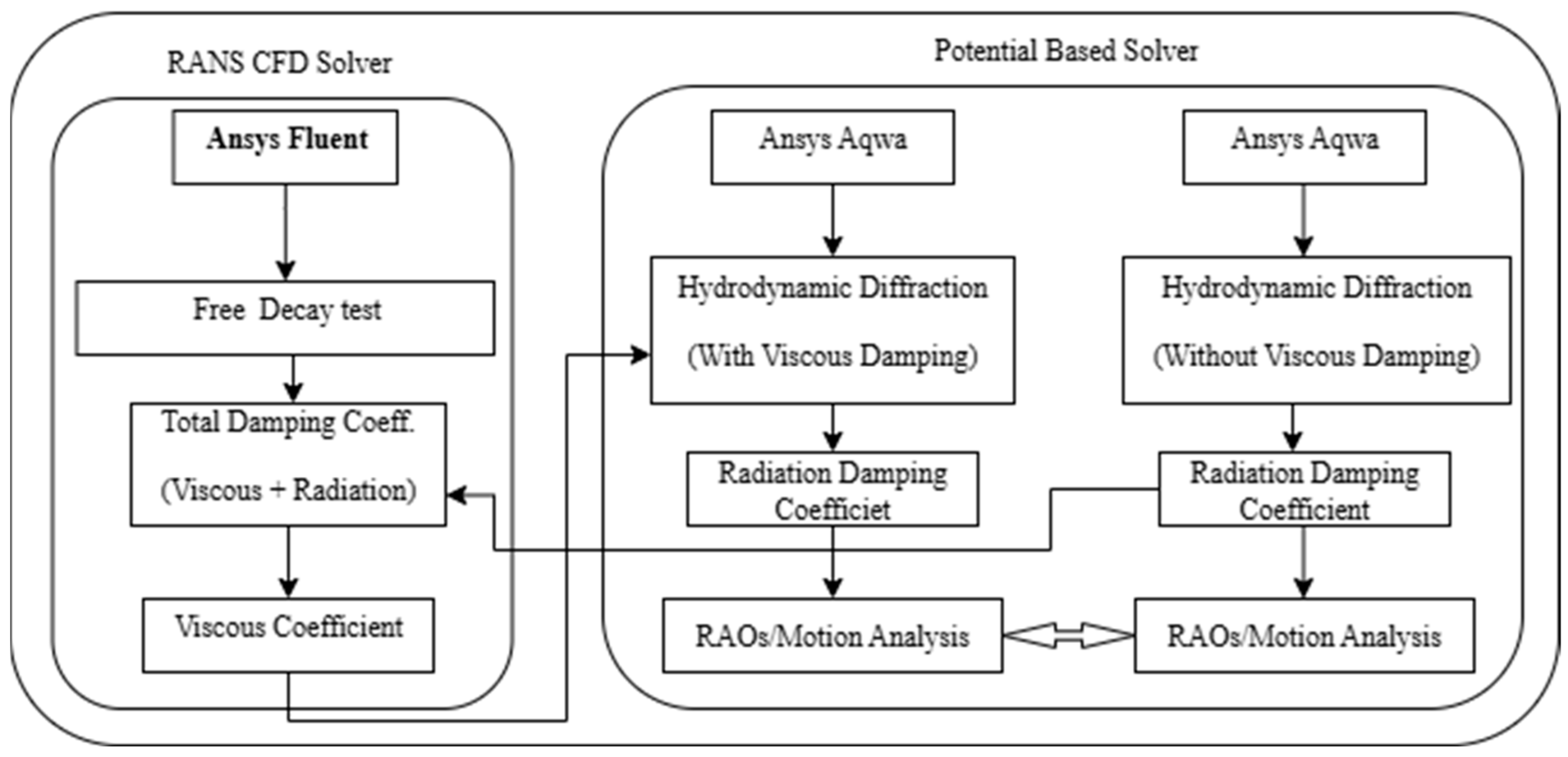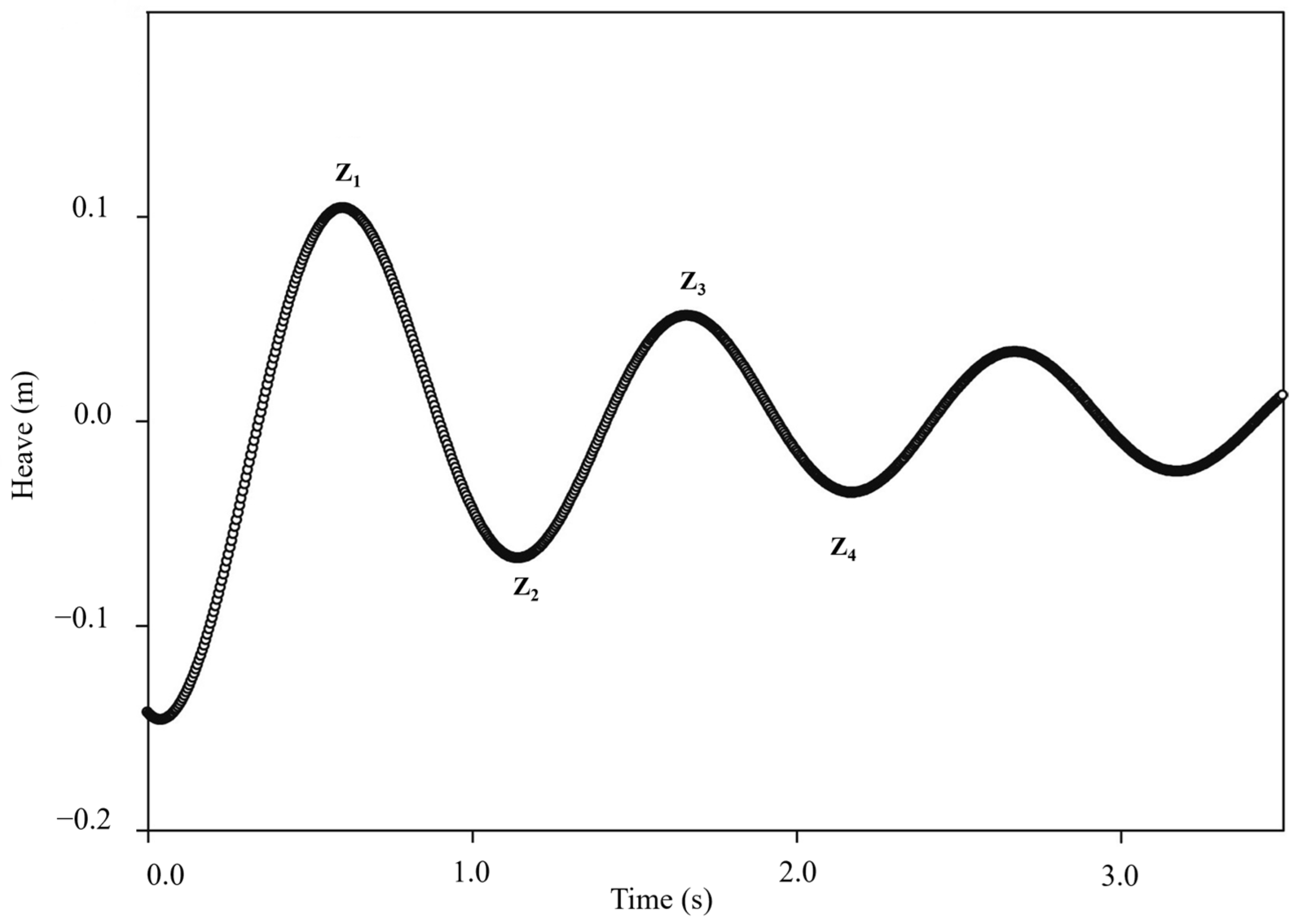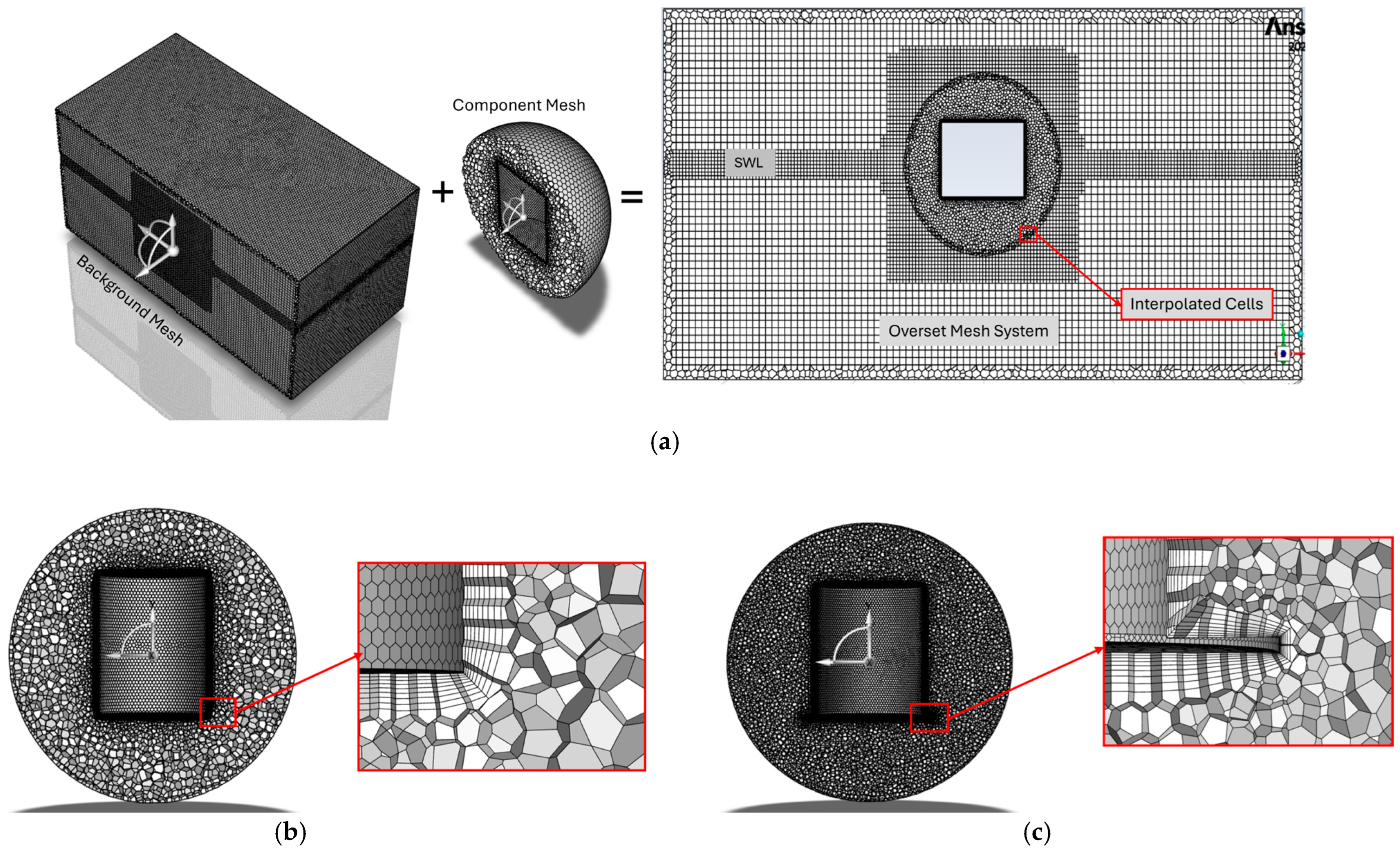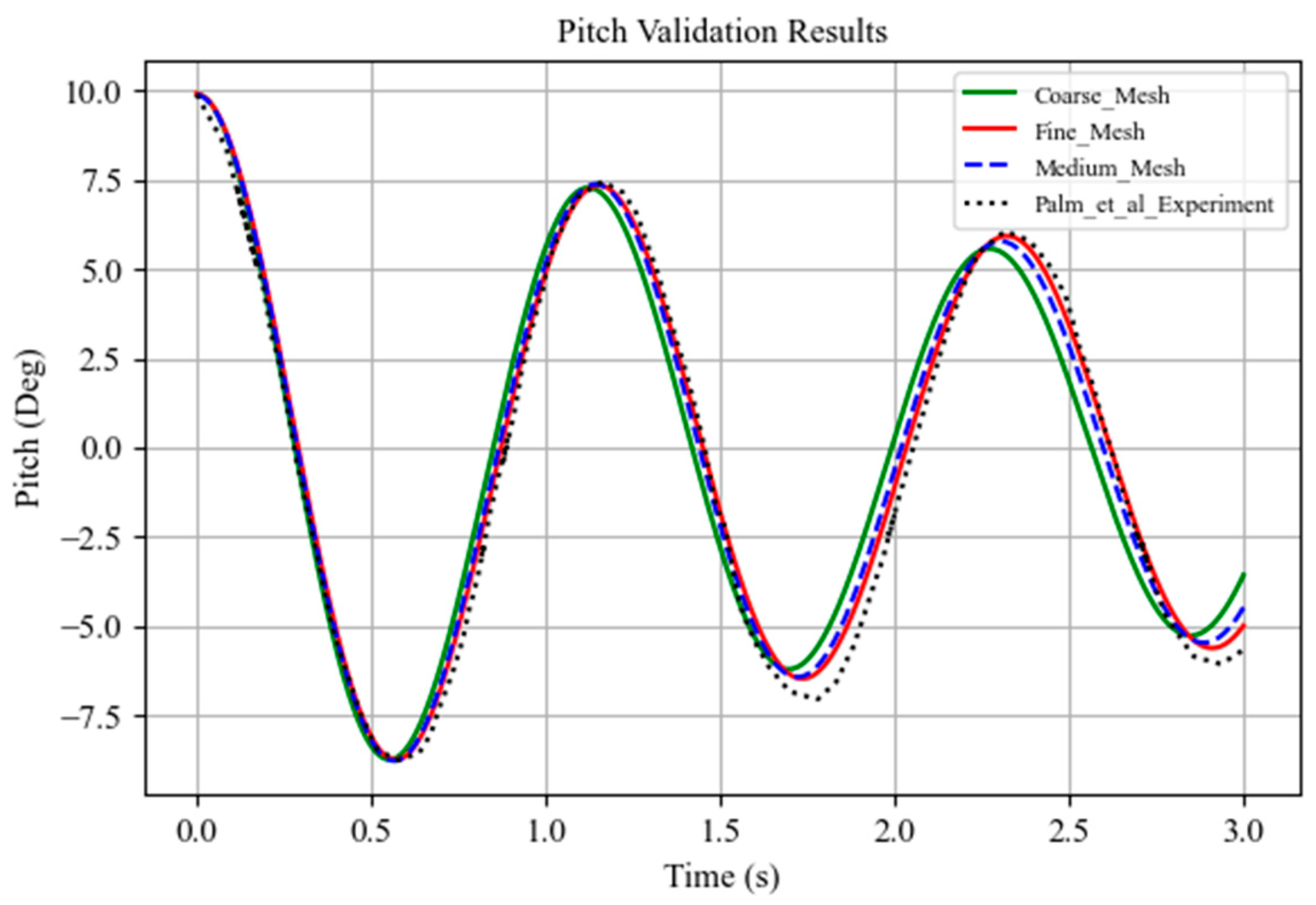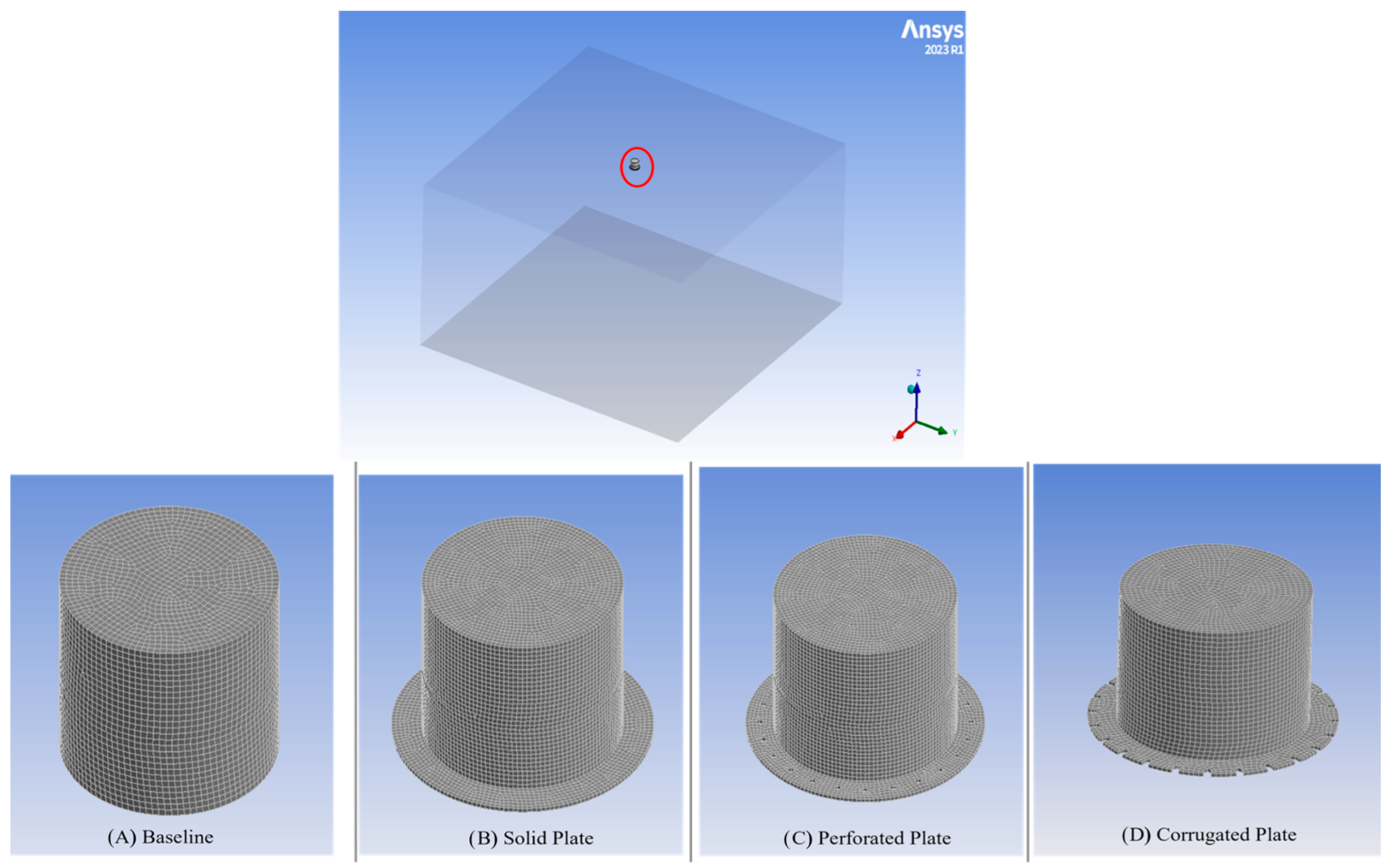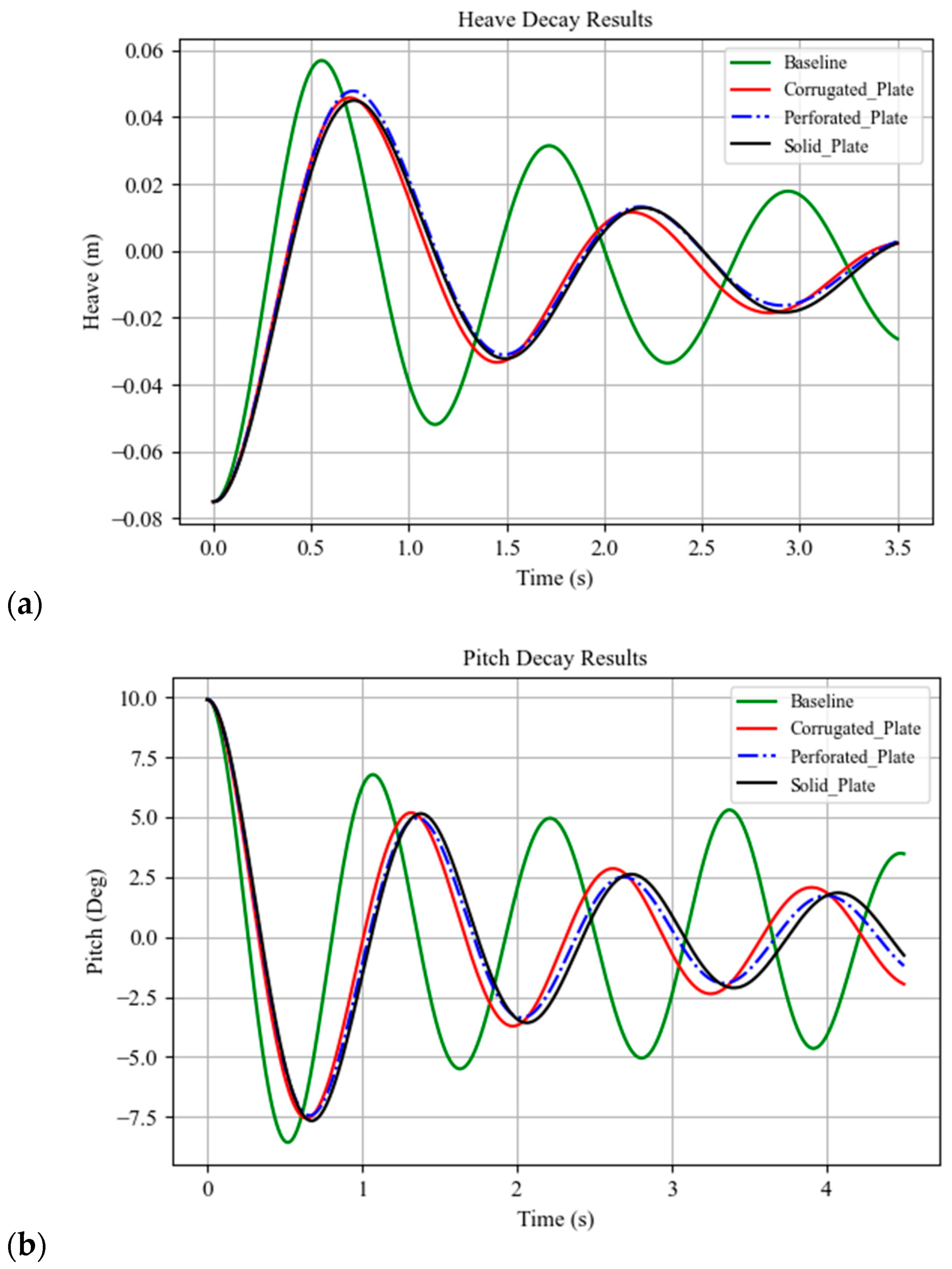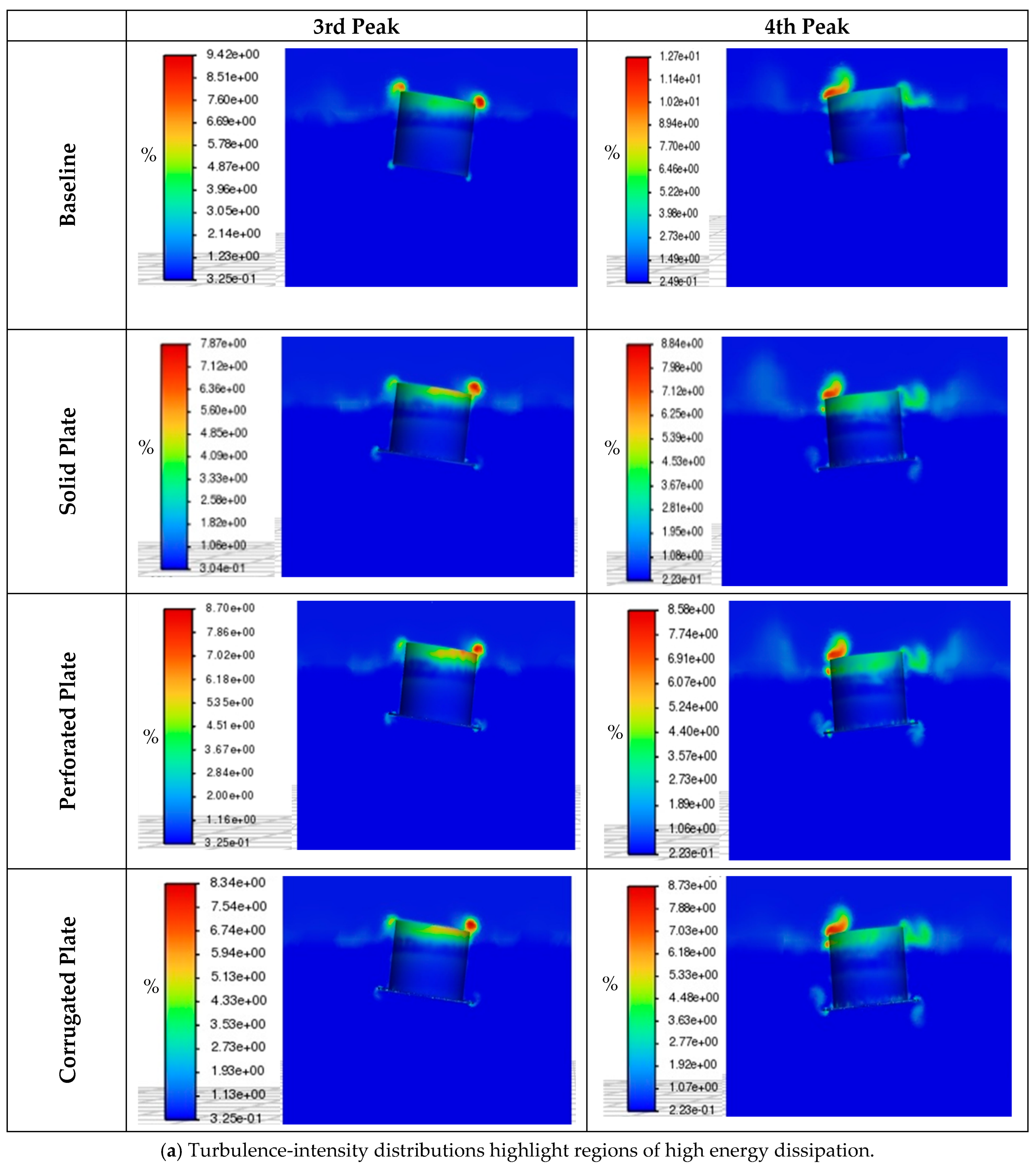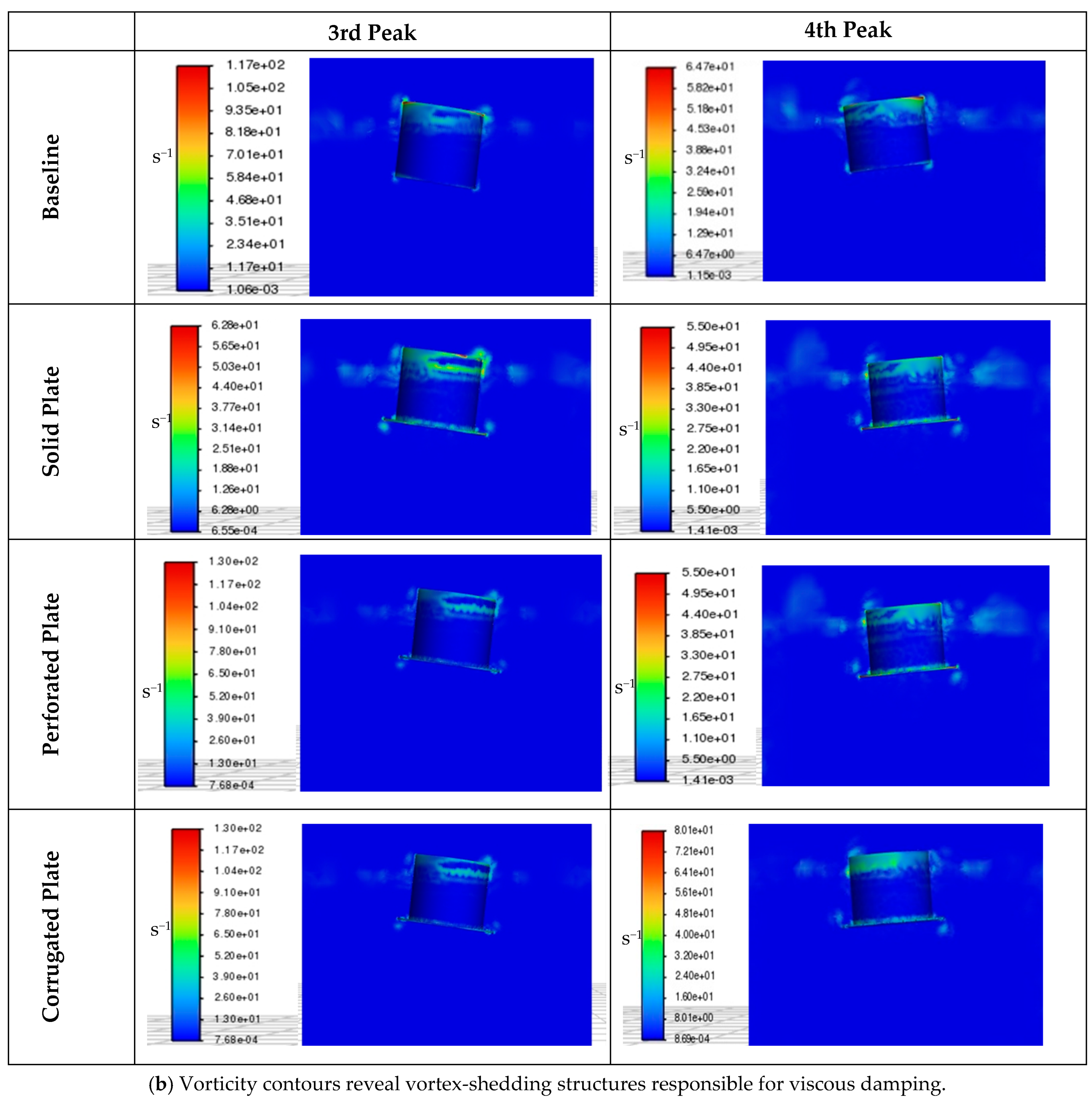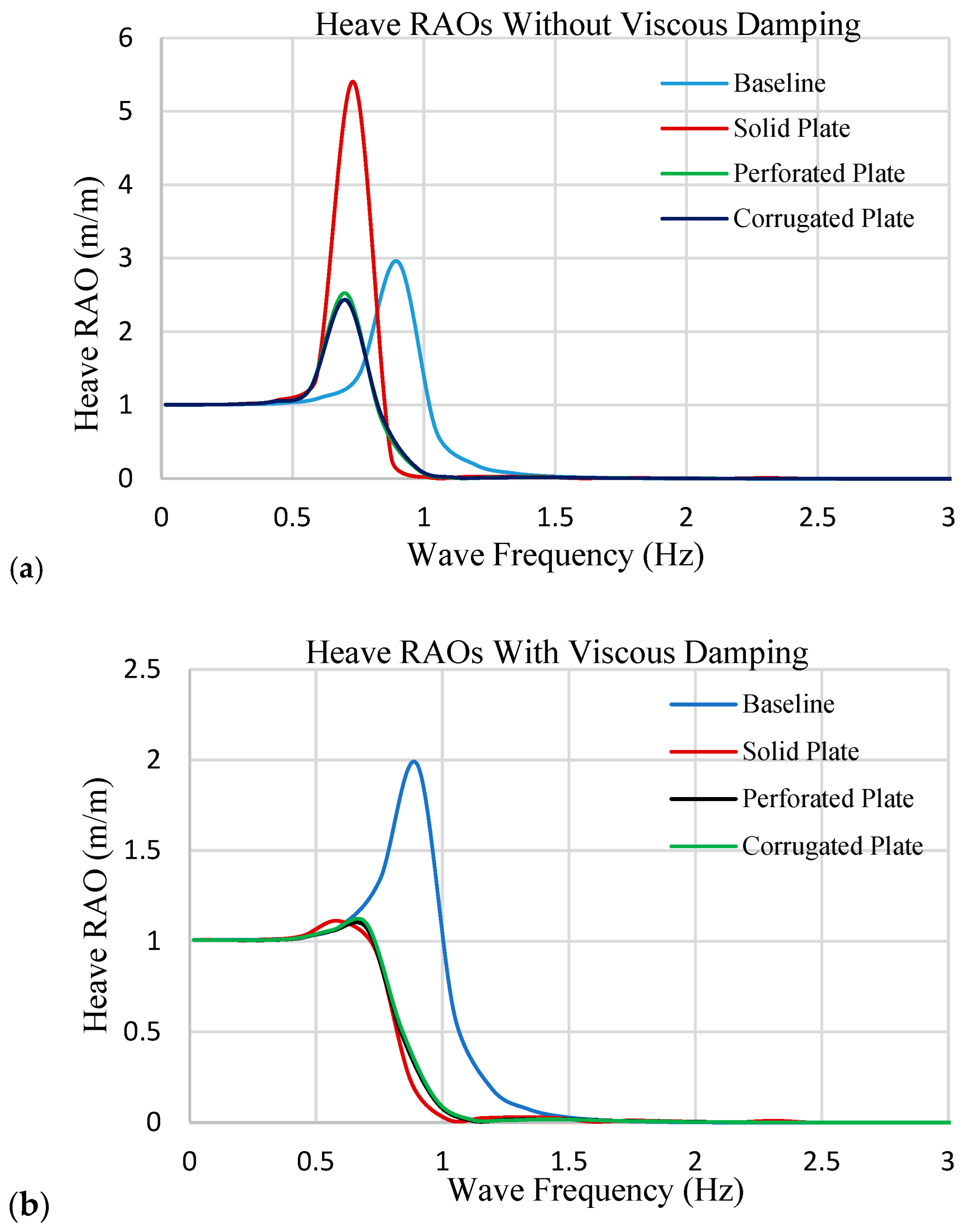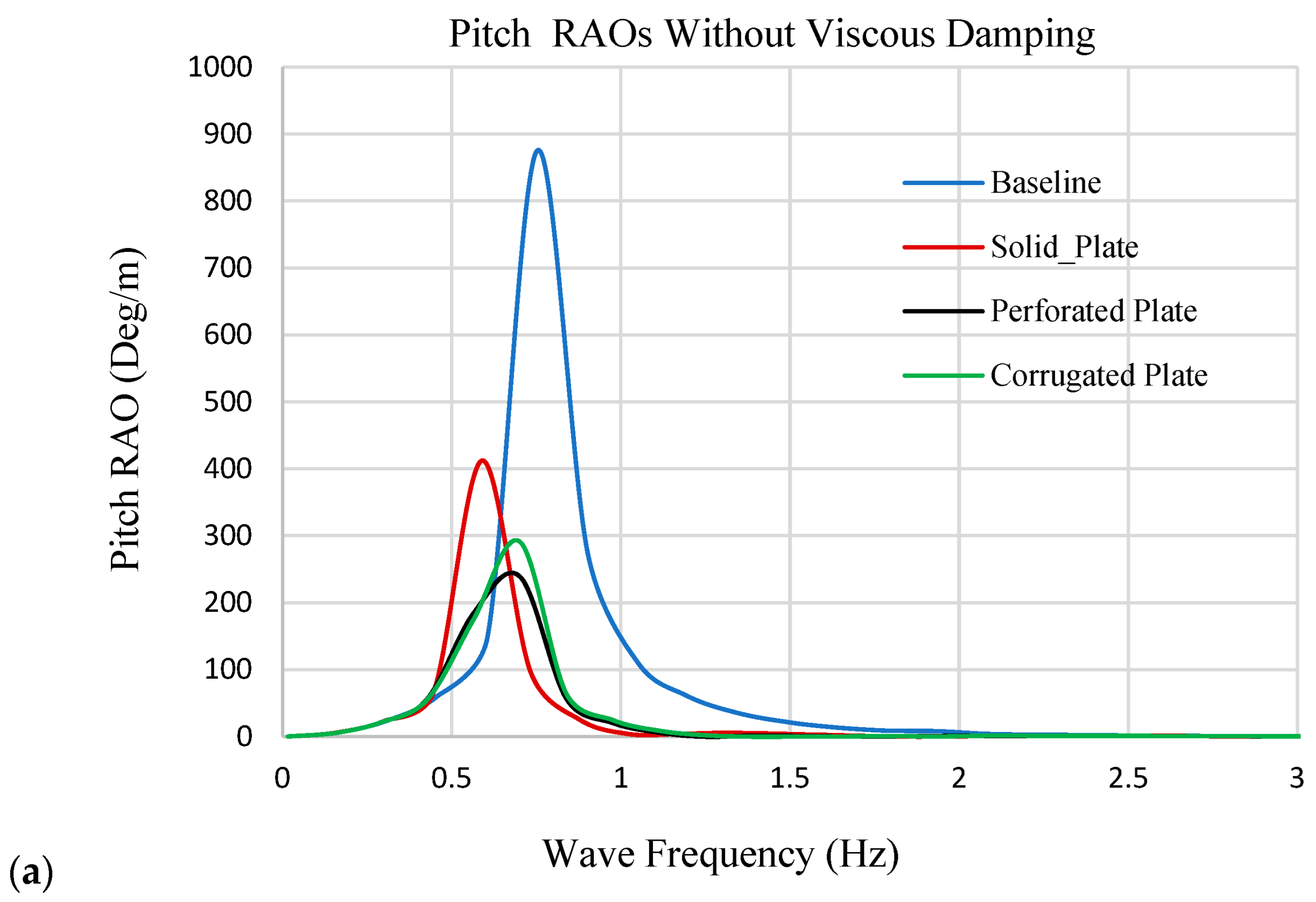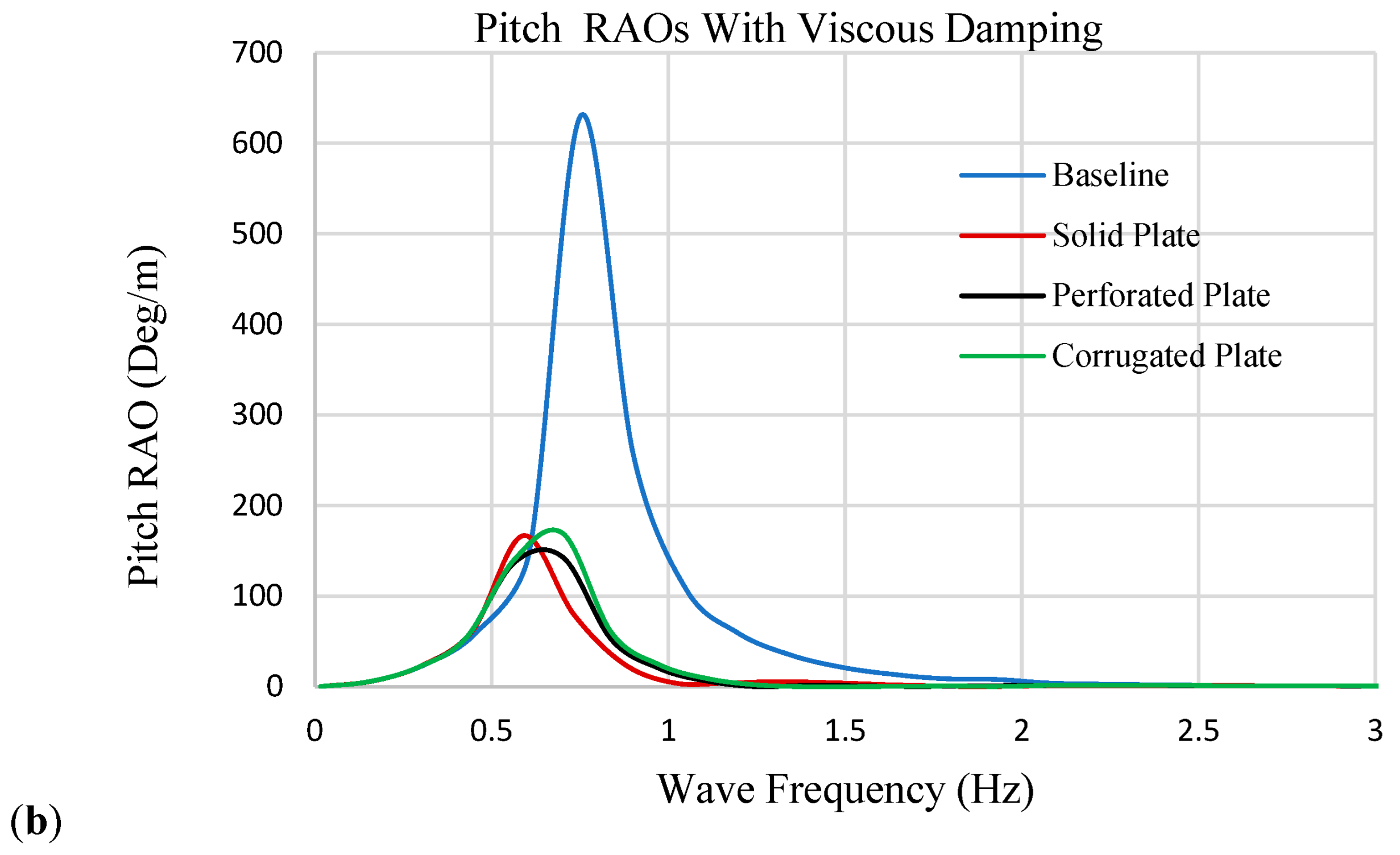1. Introduction
Spar-buoy platforms are widely used in offshore oil exploration and renewable energy applications. They provide stable floating support for deep-sea drilling systems and serve as robust foundations for offshore wind turbines where fixed-bottom solutions are not feasible. Their deep draft and slender cylindrical geometry ensure excellent stability under harsh ocean conditions. They are always stable because their center of buoyancy is above the center of gravity, as pointed out by Ciba et al. [
1]. Significant advances in offshore oil production and wind energy have been supported by the development of cylindrical spar platforms.
Spar platforms were first used in the oil industry as floating storage and offloading systems. A well-known example is the Devil’s Tower Spar, operated by Dominion Oil in 1710 m of water in the Gulf of Mexico. In September 1996, Oryx Energy deployed the first spar production platform in the Gulf of Mexico, demonstrating their feasibility for deep-water oil extraction [
2]. Today, the same technology forms the basis of modern floating offshore wind turbines (FOWTs), linking traditional offshore oil exploitation with renewable energy generation. This transition is especially important because around 80% of the global practical offshore wind energy resource lies in waters deeper than 60 m [
3].
Figure 1 shows typical applications of spar-type cylindrical hulls in both oil and gas platforms and floating wind turbines.
Recent studies have focused on improving the motion performance of spar buoys through advances in hydrodynamic analysis and damping enhancement strategies. For example, Lee et al. [
4] investigated the effect of hull flexibility on a 15 MW spar-type floating offshore wind turbine and found that flexibility shifts natural frequencies and increases nacelle accelerations and tower-base bending moments, while the 6-DOF motion platform and mooring tensions remain largely unchanged, underscoring its importance in large-scale FOWT performance analysis.
Several experimental studies have been conducted on spar buoys. For instance, Hegde et al. [
5] investigated spar-buoy platforms with heave plates through wave tank experiments and numerical simulations. Using 1:100 scale models, they compared configurations with plates at the keel and near the free surface. Results showed that a spar buoy-form with a heave plate near the free surface reduced peak heave response by about 75% and pitch by around 30%, demonstrating significant motion suppression and recommending this configuration for practical design applications. Capobianco et al. [
6] conducted an experimental study on cylindrical buoys to assess their accuracy in wave measurement. Eleven configurations, eight of which had disks at the waterline, were tested in a basin. Transfer functions were determined in regular waves and then applied to irregular wave measurements. Their analysis concluded that a buoy with a medium-sized disk provides the best compromise, accurately following the free surface while minimizing parasitic motions. Zhu et al. [
7] experimentally investigated the effect of heave plates on motion suppression for a cylindrical floating structure. Their wave flume tests showed that heave plates significantly increase added mass and reduce the peak heave Response Amplitude Operator (RAO) by about 40% compared to a plain cylinder. Similarly, Tao et al. [
8] experimentally studied the influence of solid and porous heave plates on added mass and damping in offshore structures. Bernal-Camacho et al. [
9] experimentally demonstrated that a Centerboard and Heave plate (CH) system significantly enhances the stability of a Floating Offshore Wind Turbine (FOWT). Testing in a Wave–Wind Flume, they recorded an average 27% reduction in pitch motion and a 25% mean decrease in surge, heave, and pitch responses across various sea states, validating the efficacy of appendages for motion suppression.
As an alternative to experimental approaches, computational fluid dynamics (CFD) and potential flow solvers have become increasingly important tools for offshore platforms. These numerical tools enable accurate prediction of floating platform responses under complex fluid–solid interactions [
10]. Advances in computational power now allow detailed analyses of flow–structure interactions, including vortex shedding induced by spar motion and its influence on wake characteristics [
11]. Although these simulations are computationally intensive, the availability of high-performance computing enables such complex problems to be addressed within practical timeframes.
Several numerical studies have investigated the hydrodynamic performance of spar buoys and floating offshore wind turbines (FOWTs). Nematbakhsh et al. [
12] employed a nonlinear Navier–Stokes model to analyze a 5 MW spar-buoy wind turbine under both extreme and operational sea states. Their approach captured large platform motions and nonlinear hydrodynamics without relying on experimental data or linearizing assumptions. They reported that higher aspect ratios reduce mean pitch and surge but may introduce nonlinear trends in the response standard deviations due to increased environmental loading. Similarly, Silva et al. [
13] used a statistical quaternization method to efficiently model the nonlinear, second-order response of an FOWT. Their approach accurately captured mooring forces and wave–current interactions by replacing nonlinearities with equivalent polynomial terms, solved via Volterra theory, and demonstrated excellent agreement with time-domain simulations at a computational cost roughly one hundred times lower. Xue [
14] developed a novel spar-buoy concept to support a 10 MW wind turbine by upscaling an existing 5 MW design. Using a coupled numerical model, they showed that the blade pitch controller can excite significant platform resonances and reported that the spar concept exhibits the largest surge oscillations among various platform types, whereas a semi-submersible shows larger pitch motions, and a TLP with taut moorings shows the smallest motions overall. Finally, Son et al. [
15] analyzed the motions of a newly developed lightweight buoy and, using CFD-based free-decay tests, estimated viscous damping coefficients and incorporated them into potential-flow simulations. Their results showed that the addition of appendages significantly reduced heave and pitch motions, enhancing buoy performance under wave conditions.
Hybrid experimental–numerical approaches are often used to validate and improve the fidelity of numerical models; in this case, the numerical model is used as a supplement to the experimental model. For instance, An et al. [
16] investigated the forced harmonic heave motions of submerged perforated rectangular plates through combined experiments and numerical modelling. By integrating potential-flow theory with viscous pressure loss and a boundary element method, they predicted added mass and damping coefficients that agreed well with experimental results, particularly at greater submergence depths. Yu et al. [
17] employed a combined experimental and RANS-based CFD approach to analyze a two-body point absorber wave energy converter. Their results showed that nonlinear effects, including viscous damping and wave overtopping, significantly reduce system motions and power absorption, especially in larger waves. Similarly, Rao et al. [
18] combined experiments and simulations to study spars with circular heave plates and reported significant nonlinear damping effects. Plate size, location, and spacing strongly influenced both damping and added mass, offering practical guidance for heave compensation device design; however, Rao’s plates do not have perforations. Srinivasamurthy et al. [
19] experimentally investigated spar platforms with damping plates for floating offshore wind turbines and showed that the Type-B and Type-C plate configurations effectively reduced pitch response compared with a classic spar, improving platform stability under wave loading. Although it deals with heave plates, it does not have perforation or corrugation, as in the present study. Colling et al. [
20] examined the free-decay heave motion of a spherical buoy through experiments and VOF-based simulations, demonstrating how draft strongly affects oscillation frequency and damping. While their work provides insights for buoy design in energy applications, the present study advances this by analyzing spar buoys with multiple appendages using a hybrid CFD–potential flow framework, focusing on viscous damping and motion reduction in heave and pitch.
Hybrid numerical models that combine fundamentally different governing principles, such as CFD and potential-flow solvers, offer a powerful approach to capturing viscous effects and improving the reliability of load response predictions. For example, Yang et al. [
21] investigated the load response of a 10 MW floating offshore wind turbine (FOWT) on a semi-submersible platform using CFD and hydrodynamic correction methods. By comparing damping-, drag-, and hybrid-based correction approaches, they found that the hybrid method, which combines both drag and damping coefficients, most accurately captured viscous effects and improved load-response predictions. Their results highlight the importance of integrating free-decay data with real-world conditions to enhance the accuracy of hydrodynamic modelling for large-scale FOWTs. A common approach to determine the added mass and damping coefficients of floating bodies is the free-decay test in calm water, traditionally performed with physical scale models. More recently, CFD simulations have been used to replicate these tests, allowing a detailed evaluation of viscous effects. For instance, Bezunartea et al. [
22] investigated scale effects on heave-plate hydrodynamics for floating wind platforms and showed that motion amplitude (KC number) has a much stronger influence on hydrodynamic coefficients than the scale factor itself.
Corrugated surfaces have been investigated in various hydrodynamic contexts, mainly for their capability to modulate flow separation and mitigate vortex-induced vibrations. Yu et al. [
23] experimentally analyzed a circular cylinder with symmetrically arranged corrugated surfaces and reported substantial reductions in mean drag (≈58%) and fluctuating lift (≈82%), attributed to modified shear-layer development and wake vortex reorganization. Their results demonstrated that surface corrugation can effectively weaken vortex coherence and suppress unsteady loading through flow modulation. Zhao [
24] numerically investigated the vortex-induced vibration (VIV) of a circular cylinder in spanwise shear flow and showed that transitions between vortex-shedding modes (2S–2P–2T) strongly influence vibration amplitude and frequency response, underscoring the sensitivity of bluff-body dynamics to wake topology. Together, these studies provide a physical foundation for the present work, in which corrugation is not employed for drag reduction or VIV suppression but rather as a plate-type hydrodynamic appendage aimed at enhancing viscous damping of a spar buoy under oscillatory wave-induced motion.
Building on these advances, the present study develops a hybrid CFD–potential flow framework to evaluate the motion performance of a cylindrical spar buoy while accurately capturing viscous damping effects and maintaining computational efficiency. Four spar configurations are examined under identical conditions: a baseline cylinder, a solid heave plate, a perforated plate, and a corrugated plate introduced as a novel damping mechanism. The analysis focuses on heave and pitch motions, where restoring forces are well-defined and appendages have a dominant influence on damping behavior. By benchmarking the corrugated plate against conventional alternatives, the study demonstrates how geometry-driven flow manipulation can enhance damping efficiency without significantly increasing added mass.
This work addresses a critical gap in prior studies, which have largely concentrated on spar-type buoys equipped with solid or perforated heave plates analyzed using potential-flow models that neglect viscous effects. Limited attention has been given to geometry-induced damping enhancement through structured or corrugated surfaces. To fill this gap, the present study introduces and evaluates a corrugated plate appendage as a novel passive damping mechanism within a hybrid CFD–potential flow framework. The approach quantitatively links geometry-driven flow behavior with viscous damping performance, thereby improving the predictive accuracy of motion analysis and providing new design insights for damping-optimized floating structures.
2. Hybrid Numerical Framework Methodology
Four spar cylinder configurations were examined using a consistent numerical model scale: (i) a bare (baseline) spar, (ii) a solid plate appendage, (iii) a perforated plate appendage, and (iv) a corrugated plate appendage. The Baseline, Solid Plate, and Perforated Plate are grouped as conventional appendages, similar to those examined in earlier studies, such as [
1,
5,
18,
19,
25,
26], and provide useful reference cases for comparison. In contrast, the Corrugated Plate introduces a new design concept, intended to improve damping by altering the surface geometry and increasing the plate edge perimeter.
Figure 2 illustrates the spar cylinder along with the detailed geometries of all appended configurations.
The Baseline configuration consists of a smooth cylindrical spar fabricated from steel, with a diameter of 0.515 m. All appendage configurations incorporating plates employ a heave plate manufactured from acrylonitrile butadiene styrene (ABS) plastic, which was selected as a lightweight material to limit the increase in structural mass relative to the steel hull. The heave plate diameter is set at 1.3 times that of the spar cylinder. In the Solid Plate configuration, the plate is continuous, whereas the Perforated Plate configuration incorporates 24 uniformly distributed circular openings of equal size. The Corrugated Plate configuration replaces the perforations with 24 radial ridges designed to enhance hydrodynamic interaction by increasing the perimeter of the plate edge.
The inclusion of plates increases the total mass by approximately 4% relative to the Baseline case; the associated increase in buoyancy counteracted this effect, ensuring that the hydrostatic stability of all configurations was preserved. The configurations and their respective dimensions in millimeters are illustrated in
Figure 2.
The principal hydrostatic characteristics of the baseline and appendage-equipped configurations were evaluated to provide input for the subsequent motion analysis. These include displacement volume, draft, centers of gravity (CG) and buoyancy (CM), metacentric height (GM), and mass moment of inertia. The results are summarized in
Table 1. These quantities form the basis for the restoring stiffness terms
C33 (heave) and
C55 (pitch), as well as for the effective mass and inertia definitions, with the corresponding equations given in
Section 2.2 Governing Equations of Motion. Notably, the mass increase due to the plate appendages was limited to approximately 4% relative to the baseline, with minimal impact on draft and buoyancy, which remains within acceptable limits. This is evident from the draft in
Table 1 below.
2.1. Coupling Procedure and Study Workflow
This study implements a hybrid numerical framework that couples a RANS-based CFD solver (ANSYS Fluent) with a potential-flow solver (ANSYS AQWA) to predict RAOs with explicit inclusion of viscous effects. The overall procedure, illustrated in the workflow diagram in
Figure 3, begins with free-decay simulations in Fluent for heave and pitch, yielding decay curves from which the total damping coefficients were calculated using the logarithmic decrement ratio, as defined in Equation (17) in
Section 2.3. At the corresponding decay natural frequencies, radiation damping coefficients were obtained from AQWA and subtracted from the total damping to isolate the viscous component, following Equation (20) in
Section 2.3. These viscous damping coefficients were then incorporated into AQWA’s hydrodynamic diffraction analysis to compute RAOs, ensuring that both radiation and viscous effects were represented in the motion predictions. This procedure was applied to all configurations to enable consistent comparison of their hydrodynamic performance under regular wave forcing.
2.2. Governing Equations
The motion of a floating body subjected to wave-induced forces is governed by second-order differential equations, accounting for inertia, damping, and restoring forces. The general form of the equation of motion [
27], is given by:
Here M denotes the generalized mass matrix (kg), incorporating both structural and added mass components. B is the hydrodynamic damping matrix (kg/s), while C is the stiffness matrix (kg/s2) representing restoring forces. The vector x(t) describes the translational and rotational displacements, and F(t) represents the external force vector.
For the heave and pitch degrees of freedom, the governing equations can be decoupled and written as:
In Equations (2) and (3), z denotes the vertical (heave) displacement of the floating body in meters, and θ represents the pitch angle in radians. M33 and I55 correspond to the structural mass and mass moment of inertia, respectively, while a33 and a55 refer to the added mass and added moment of inertia components. The coefficients B33 and B55 account for hydrodynamic damping (in kg/s), and C33 and C55 represent the hydrostatic restoring stiffness (in kg/s2). The terms Fz(t) and Tθ(t) denote the external wave-induced force and moment acting on the body in the heave and pitch directions, respectively.
The governing fluid motion is described by the continuity and Reynolds-Averaged Navier–Stokes (RANS) equations. For incompressible, turbulent flow, the continuity equation is expressed as [
28]:
The RANS momentum equations in the
x,
y, and
z directions are:
Here
ρ is the fluid density,
u,
v, and
w are the velocity components in each direction,
p is the pressure,
μ is the dynamic viscosity of the fluid and
,
and
denote the body forces per unit volume, such as gravity. ANSYS Fluent solves these equations using the Finite Volume Method (FVM) [
29], which discretizes the computational domain into control volumes. The governing equations are then integrated over each control volume, ensuring local conservation of mass and momentum.
The hydrodynamic analysis in ANSYS AQWA is based on the linear potential-flow theory, assuming the fluid to be inviscid, incompressible, and irrotational [
30,
31]. The total velocity potential,
ϕ, is expressed as
where
ϕI is the incident potential,
ϕD the diffraction potential, and
ϕRj the radiation potential corresponding to a unit motion in the
j-th degree of freedom. Each potential satisfies the Laplace equation in the fluid domain,
subject to the linearized boundary conditions for small-amplitude waves. The free-surface condition is given as
The seabed condition is
and the body-surface condition is expressed as
where
g denotes gravitational acceleration,
h is the water depth,
n is the outward unit normal vector on the body surface, and
Vb is the body velocity vector. Solving these boundary-value problems yields the frequency-dependent hydrodynamic coefficients of added mass
aij(ω) and radiation damping
rij(ω) and wave-excitation force
(ω), which are related by
These coefficients form the linear frequency-domain equation of motion used to compute the response-amplitude operators (RAOs):
where
M and
C denote the structural mass and hydrostatic restoring-stiffness matrices, respectively.
The hydrodynamic added-mass and radiation-damping coefficients are obtained over the wetted body surface
Sb as
where
ΦRi is the radiation potential due to a unit motion in the
i-th degree of freedom,
ρ is the water density, and the operators
ℜ[⋅] and
ℑ[⋅] denote the real and imaginary parts corresponding to radiation damping and added mass, respectively.
The natural frequency and total damping ratio of each motion mode
i can then be expressed as
where
Bii denotes the overall damping coefficient including both radiation and viscous components.
The corresponding frequency-response function or Response-Amplitude Operator (RAO) is defined as
with
A being the incident-wave amplitude.
In the present study, the heave RAO is reported in nondimensional form as the ratio between the heave response amplitude and the incident-wave amplitude, ∣Z∣/A, while the pitch RAO is reported in dimensional form as the angular response amplitude per unit incident-wave amplitude, expressed in degrees per meter.
The hydrodynamic coefficients obtained from AQWA are subsequently coupled with the viscous-damping components derived from CFD simulations (see
Section 2.3 Separation of Damping Components) to form the hybrid prediction framework.
2.3. Separation of Damping Coefficient
The viscous damping coefficients for heave and pitch are estimated from free decay tests, where one degree of freedom is isolated. This decoupling enables the application of simplified motion equations (Equations (2) and (3)). The damping ratio
ζ is calculated using the logarithmic decrement method [
31] as defined in Equation (16), based on four successive extrema, two peaks, and two troughs from the free decay curve shown in
Figure 4. It should be noted that
Figure 4 shows a representative heave-free decay curve only to illustrate the logarithmic decrement procedure described in Equation (16). The full CFD decay results for all configurations are presented later in
Section 5.
Once
ζ is determined, the total damping coefficient
Bii or heave (
i = 3) and pitch (
i = 5) is obtained as [
26]:
where
Mii denotes the structural mass (or moment of inertia),
aii the added mass (or added moment of inertia), and
Cii is the hydrostatic restoring stiffness.
The stiffness terms for heave and pitch are computed using the equation below [
32]:
where
Aw is the waterplane area,
∇ is the displaced volume, and
GM is the metacentric height.
To separate the viscous effects from the total damping obtained in CFD, radiation damping
rii(ωo) obtained from AQWA at the natural frequency
ωo are subtracted from
Bii as expressed in Equation (20a,b):
The viscous damping coefficient was determined from the results of free-decay simulations performed in ANSYS Fluent, following a systematic procedure to isolate viscous effects from the total damping. During the decay tests, the spar buoy was displaced in heave and pitch from its equilibrium position and released to oscillate freely under gravity and hydrostatic restoring forces. The resulting time-history decay curves of motion amplitude were recorded and analyzed to determine the total damping coefficient using the logarithmic-decrement method defined in Equation (16). This method evaluates damping from the exponential decay of successive oscillation peaks, thus capturing both radiation and viscous contributions present in the CFD solution. To isolate the viscous component, the radiation-damping coefficients corresponding to the natural frequencies identified from the decay tests were obtained independently from ANSYS AQWA. The viscous damping term was then calculated as the residual difference between the total damping from CFD and the radiation damping from the potential-flow analysis, as shown in Equation (20a,b). Once computed, the values were implemented in AQWA as external linear damping coefficients for the heave (i = 3) and pitch (i = 5) modes. These coefficients were combined with AQWA’s frequency-dependent radiation damping during the RAO analysis, enabling the hybrid framework to incorporate nonlinear viscous effects into the AQWA potential-flow solver.
As for hydrostatics, the metacentric height
GM is given by:
where
BM is the distance from the center of buoyancy to the metacenter, and
BG is the distance from the center of buoyancy to the center of gravity. Finally, the effective mass and moment of inertia for each mode are expressed as
6. Conclusions
This study investigated the hydrodynamic behavior of a spar-type buoy fitted with solid, perforated, and corrugated plate appendages under wave excitation, with emphasis on the role of viscous damping in suppressing oscillatory motions. A hybrid numerical framework was established by coupling CFD-based Fluent free-decay simulations with potential-flow analysis in AQWA, thereby overcoming the common limitation of potential-flow solvers that neglect viscous effects. Validation against published experimental data confirmed the reliability of the extracted damping coefficients and RAO predictions.
The results showed that all appendages enhanced damping performance in both heave and pitch, though by different mechanisms. The perforated plate consistently achieved the most efficient damping through intensified vortex shedding and turbulence-driven energy dissipation. The corrugated plate, introduced here for the first time as a damping mechanism for spar buoys, delivered competitive performance, particularly in heave, by promoting distributed flow separation along ridge edges and sustaining wake turbulence without excessively increasing added mass. This highlights its potential as a tunable design that balances damping efficiency with hydrodynamic inertia. The solid plate, by contrast, produced strong absolute reductions but relied mainly on inertia, making it less efficient per unit mass. These findings underline that geometry-based flow manipulation can provide more effective damping than simply increasing structural mass or surface area, which is especially relevant for floating offshore wind platforms where weight minimization is a critical objective.
Incorporating CFD-derived viscous damping into the potential-flow model substantially reduced resonant RAO amplitudes by more than 50% for both heave and pitch across all appendage-equipped cases. The present analysis was limited to single-degree-of-freedom free-decay tests under regular wave forcing. Future work will extend the framework to six-degree-of-freedom (6-DOF) motion simulations, incorporate mooring dynamics, and evaluate irregular and extreme sea states to better represent real offshore conditions. Methodologically, adopting scale-resolving turbulence models (LES or DES) and formal uncertainty quantification will further improve the robustness of damping predictions. For the corrugated plate, parametric investigations of ridge height, wavelength, spacing, and slot dimensions, together with experimental validation in wave basins, are recommended to optimize viscous damping efficiency while minimizing added mass.
